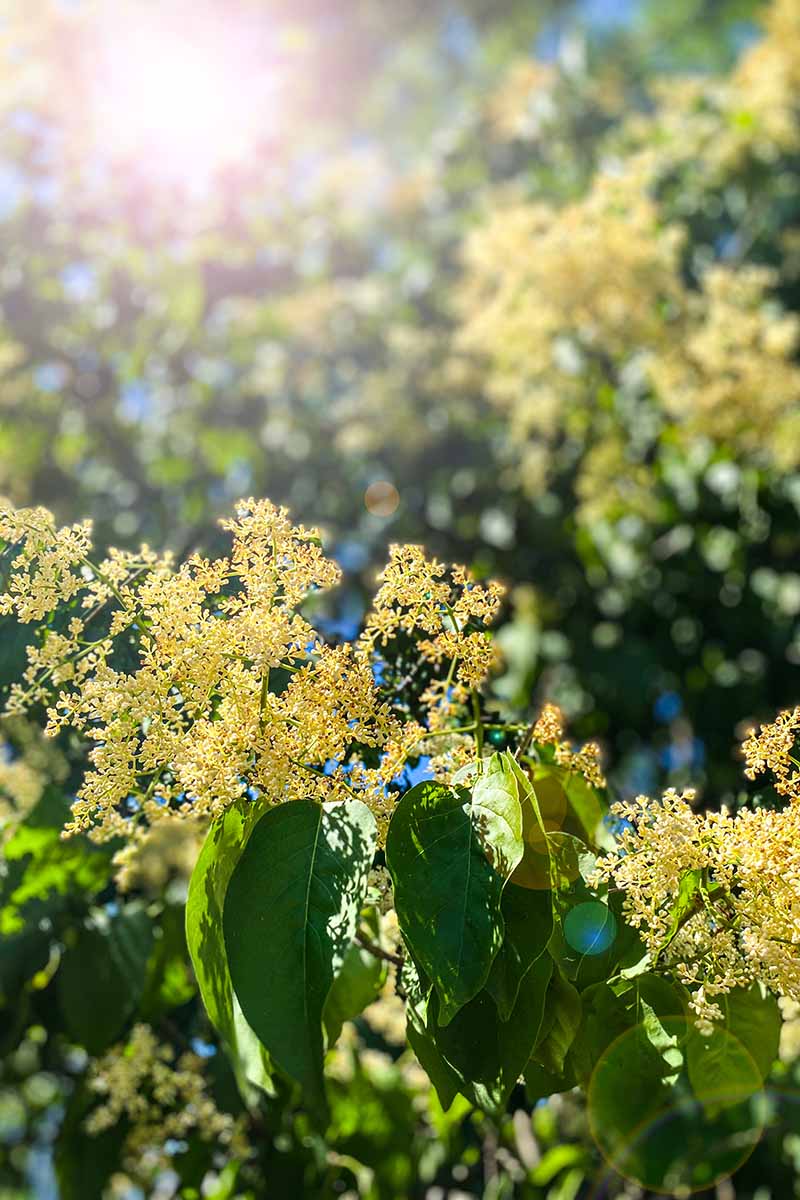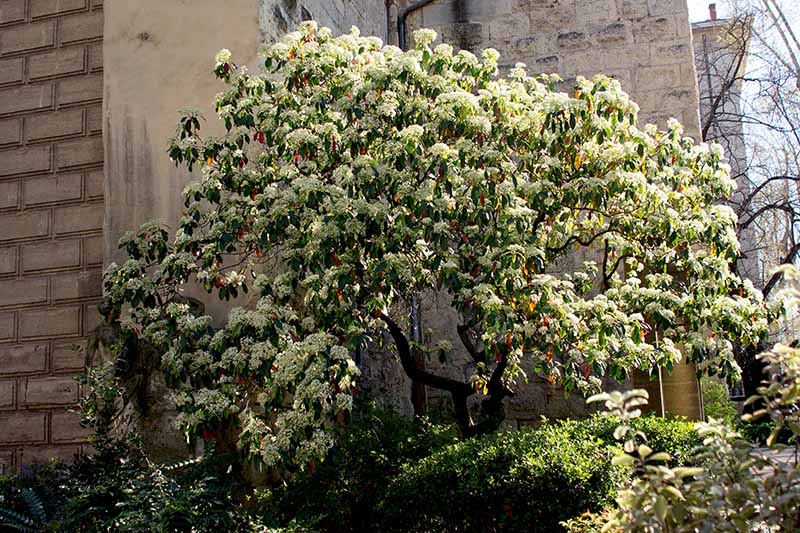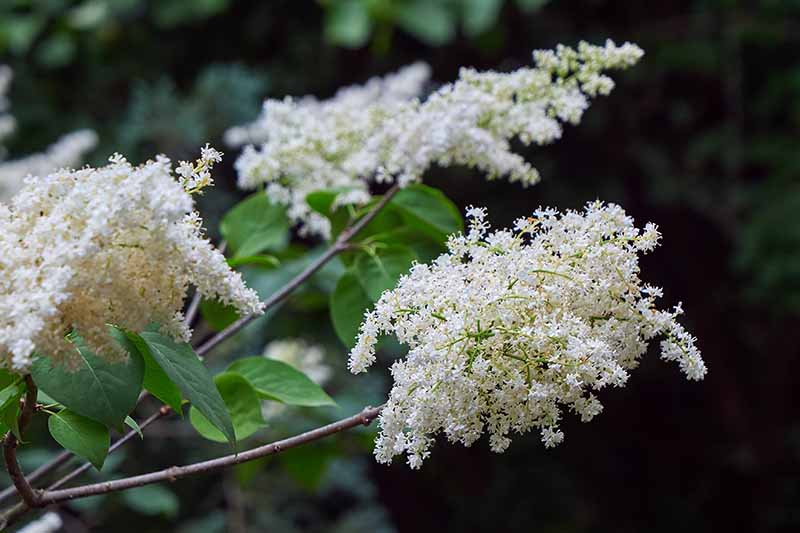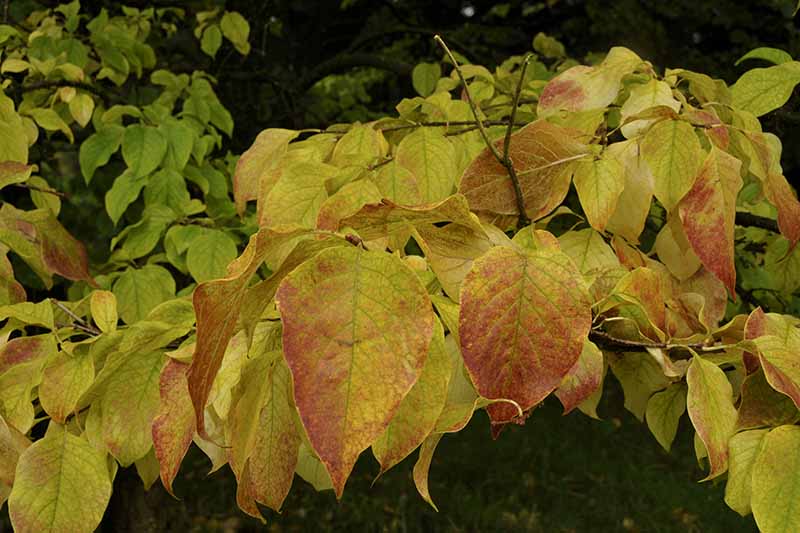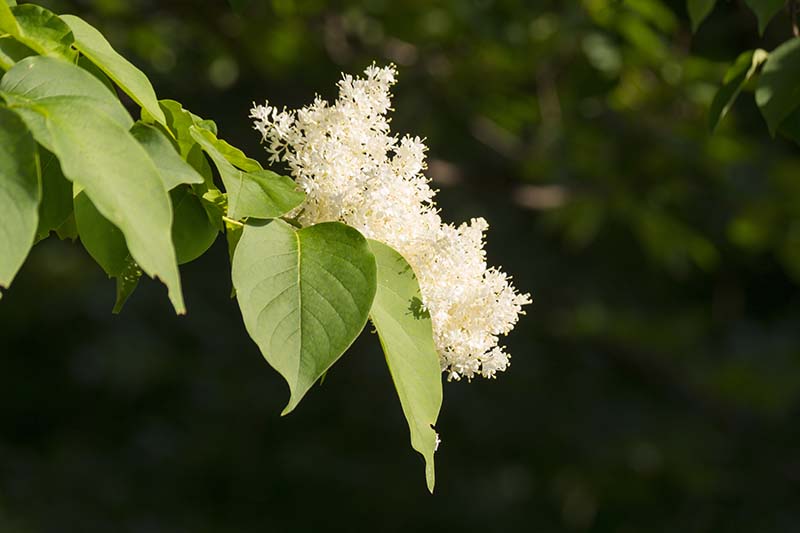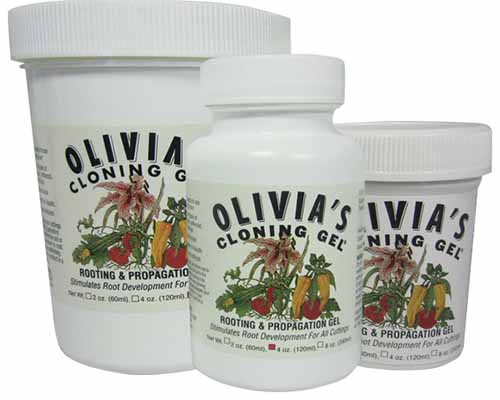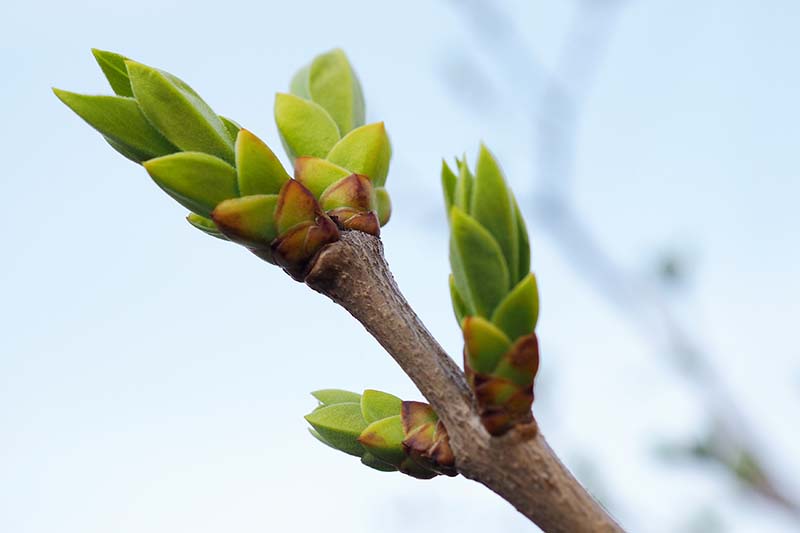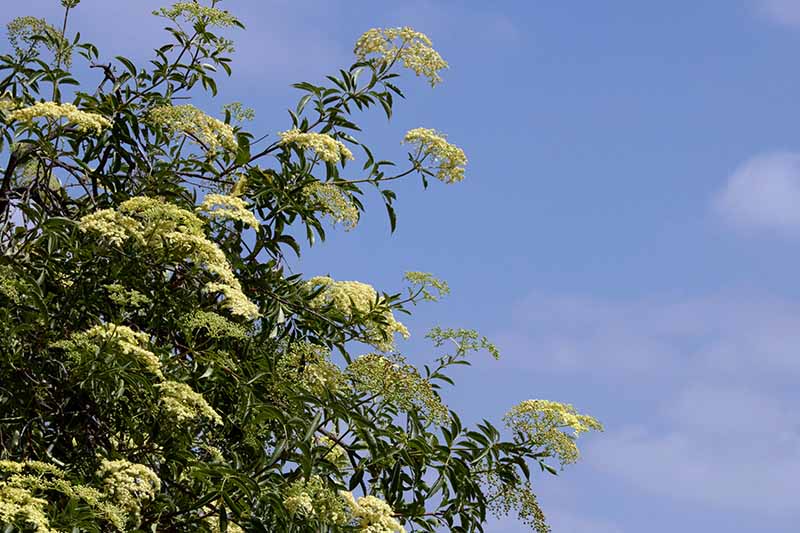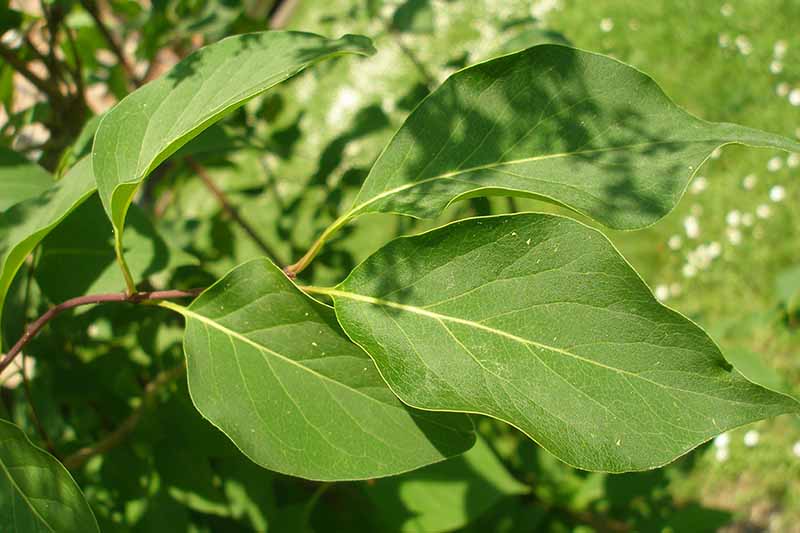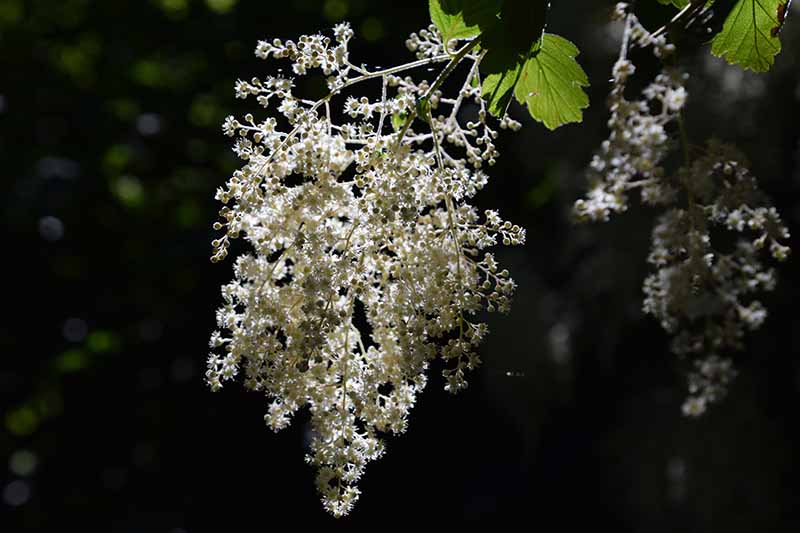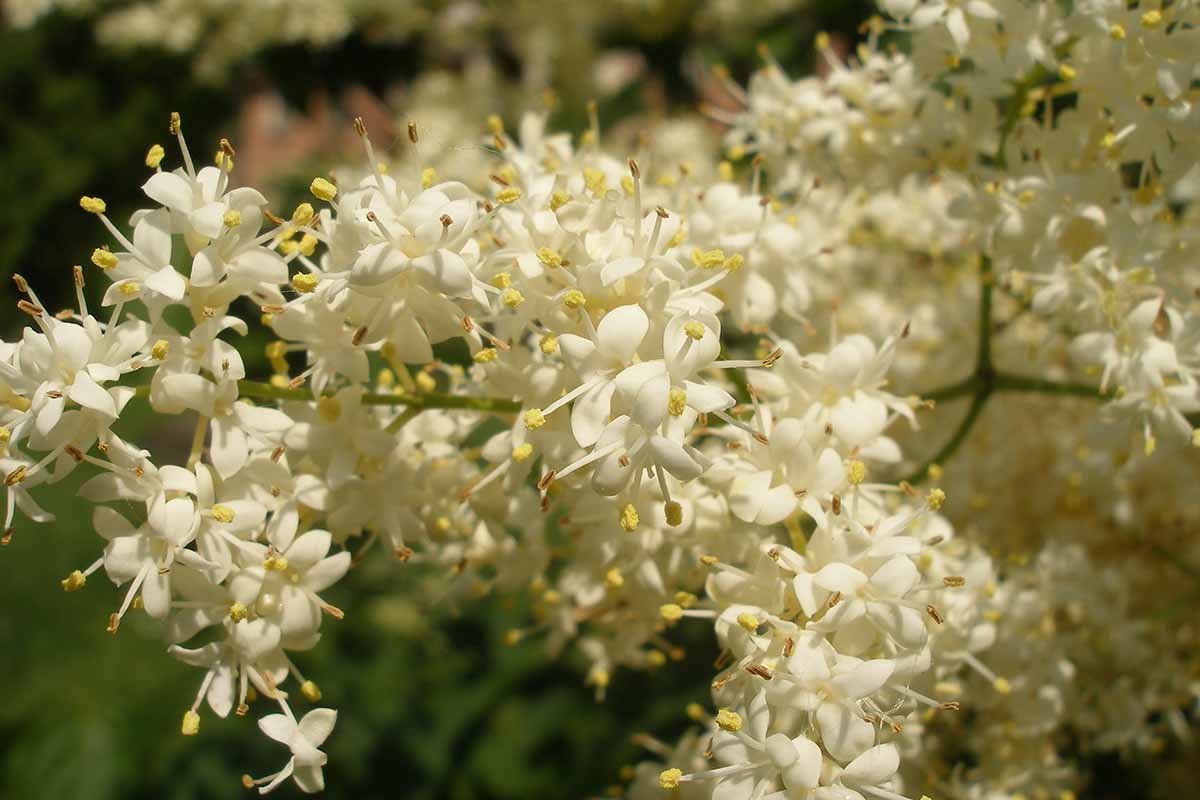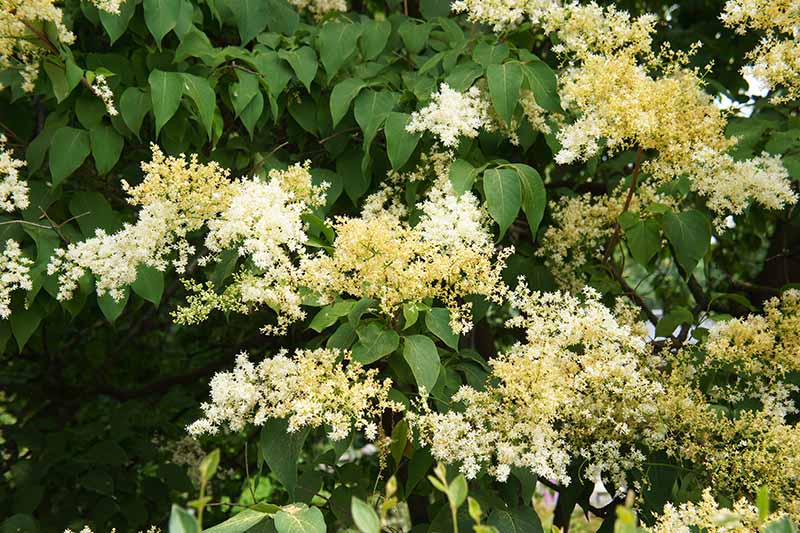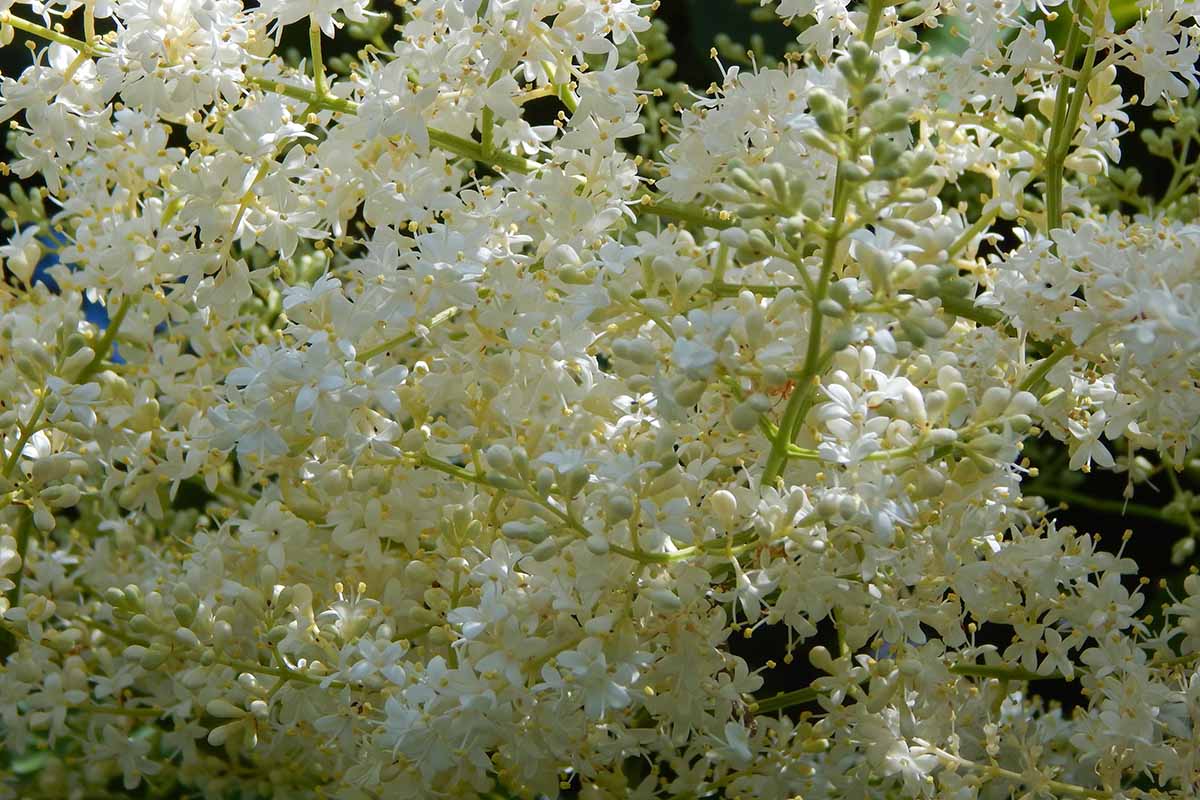It produces the most beautiful clusters of fragrant, cream-colored flowers each spring, and it’s a dream to catch a whiff of them when you walk by. If you love lilacs and you want to add a lilac tree to your garden instead of – or in addition to – a shrub, this is the guide for you. This species will make a stunning, relatively trouble-free addition to your yard. We link to vendors to help you find relevant products. If you buy from one of our links, we may earn a commission. Are you ready to find out how to plant a Japanese lilac? Let’s get started! Here’s what I’ll cover:
What Is Japanese Tree Lilac?
As you probably guessed from its common name, the Japanese tree lilac is native to Japan, specifically the northern part of the country, and gardeners began cultivating this deciduous tree there as early as 1876, according to the experts at Bernheim Arboretum and Research Forest in Clermont, Kentucky. The full name for this tree is S. reticulata subsp. reticulata. There are two additional subspecies that are related to Japanese lilac trees, but they hail from other geographic regions and are a tiny bit different. The S. reticulata subspecies pekinensis, or the Chinese lilac tree, is native to China; and S. reticulata subsp. amurensis, also known as the Amur lilac, is native to Korea and eastern Russia. The Japanese lilac is in the same genus as shrub lilacs – Syringa, which comes from the Greek “syrinx,” meaning pipe, and refers to the hollow plant stems found in some Syringa species. Reticulata is a variation of the Latin “reticulatus,” which means netted, and refers to the netted vein pattern in the leaves. Japanese tree lilacs are part of the olive family, Oleaceae, along with other fragrant, flowering plants like jasmine (Jasminum spp.) and privet (Ligustrum spp.). Some gardeners even say the flowers of S. reticulata smell more like privet than common lilac, S. vulgaris – a potential drawback, depending on your preferences. S. reticulata is suited to Zones 3 through 7, making it perfect for northern gardeners. It grows 15 to 30 feet tall and 15 to 20 feet wide, larger than other lilacs, and the canopy develops in a pleasing oval or round shape that is wider at the base and narrower at the top. The tree blooms a little later than the common lilac, in June instead of May. The small flowers last up to two weeks and are borne on panicles that can be up to a foot long. The leaves are simple but beautiful, vivid green with an oval shape, and they turn gold or yellow in the fall. After blooming, the flowers turn brown and, if they were pollinated, produce small, pod-like capsules containing two winged seeds. The capsules will stay on the tree even after the leaves fall off in wintertime. Eventually, wind and storms will scatter them throughout the area for the birds to enjoy. S. reticulata bark is a beautiful brownish-red color that matures to gray. Over time, the bark becomes more rough, developing gray scales. If allowed to grow naturally, as a large shrub, it will have multiple trunks, though it can be pruned into a tree form with one main trunk.
Propagation
While you can propagate lilacs from cuttings, your success rate may be low. But you can always give it a try, and it’s the best way to get an exact clone of the parent plant – unlike attempting to grow it from seed. Growing these plants from seed is a lengthy and time-consuming process. In a study for the American Society for Horticultural Science, researchers found that the seeds lose viability as they dry out, meaning you’d need to collect them fresh off a tree before they lose their natural moisture. Dry seeds have a low germination rate, and they need soaking and two months of cold stratification to sprout. After that, plants propagated from seed can take four to five years to begin blooming. Most gardeners opt to propagate lilacs from cuttings or purchase young plants instead. When it comes to growing these trees commercially, nurseries typically use grafting or budding methods to propagate new trees. Bare root plants that have not been grafted onto other types of rootstock are also available. The easiest way to grow a Japanese tree lilac is to purchase a live plant from a nursery or garden center. If you still want to give home propagation a try, we’ll cover rooting cuttings below, and then explain how to transplant a young bare root plant or potted tree into your yard.
From Cuttings
The best time to root lilac cuttings is in late spring or early summer, when blooms are spent and growth has begun again. Before you start, fill four eight- to 10-inch pots with a mixture of half sand and half potting soil. Make sure the pots have adequate drainage holes. Water each so the medium is moist, and use your finger to poke a two-inch-deep hole in the center of each one. Choose a branch that’s relatively young but not too young: it should bend easily and break. If it doesn’t bend at all, it’s too old; if it bends but doesn’t break, it’s too green. Using a sharp, clean pair of pruners, make a 45-degree cut on a young branch that’s three to five inches long, and contains at least two to three nodes with leaves growing. For the best chance at getting at least one cutting to root, take three more cuttings. Remove the leaves from the bottom two inches of each branch, making sure to leave at least two leaves at the top of each cutting. You can also use a gallon-sized plastic bag to cover each cutting, affixing it to the container with a rubber band. Olivia’s Cloning Gel You can purchase Olivia’s Cloning Gel in two-, four-, or eight-ounce bottles from Arbico Organics. Place each cutting in its pre-watered container, burying two inches of the stem. Cover with a humidity dome and place atop a heat mat for best results; you want the cuttings to stay warm and moist. Make sure your cuttings receive a few hours of indirect sun from a window, but not intense sun. Keeping them on a kitchen table set a few feet away from a window is ideal. Keep the cuttings evenly moist, removing the humidity domes to water the rooting mix every two or three days, or whenever the top of the soil starts to feel dry. Roots should form within four to six weeks. To check, gently tug a cutting upward. If it resists your efforts, roots have formed. Remove the humidity dome and heat mat, and set the pot or pots in a sunny windowsill to receive four to six hours of indirect sunlight a day. If you don’t feel any resistance, give the cuttings another two to three weeks to produce roots before tossing them out. For reference, an eight-inch round pot holds about one gallon of potting mix, and a ten-inch pot holds three. Fertilize your new plant, or plants, with a fertilizer for acid-loving plants in the spring after the cuttings take root. Dr. Earth Organic Acid Lovers Fertilizer Dr. Earth’s Organic Acid Lovers formula is available in a one-pound package from the Home Depot. This is a 3-4-3 NPK formula that works well for lilacs. Use two tablespoons for each gallon of potting soil. Water your fledgling trees any time the top inch of soil dries out. To check the soil moisture, poke your index finger down about an inch into the potting mix. With the right amount of water, sun, and patience, your new Japanese lilacs should grow reliably indoors, all winter long. When springtime comes, you can begin to harden the plants off by placing them outside for increasing amounts of time each day. Once your lilacs are accustomed to spending most of the day outside, it’s transplant time!
Transplanting
Whether you’re transplanting a young, potted tree, a bare root plant, or a cutting you propagated yourself, the process of transplanting is similar. The best time to plant your tree outdoors is somewhere between March and November, as long as the soil is workable. Bare roots should be put in the ground in early spring or late fall, or whenever the trees in the surrounding area are dormant. It’s best to plant these promptly after you receive them, if you’re able to. First, choose a site outdoors that receives six to eight hours of sun every day. The area should have well-draining, organically rich, slightly acidic soil. If you’re not sure what type of soil you have, you can conduct a soil test. Next, dig a hole that’s as deep and wide as the root ball you’re working with. If you’re planting a bare root specimen, the hole should be as deep as the mass of roots and about six inches wider. Before you dig the hole for a bare root plant, unwrap it from its packaging and soak the roots in water for at least half an hour, but not longer than two hours. Bare root plants need to stay moist through planting time. Work well-rotted compost or manure into the soil. You’ll want to work two inches of compost or manure into the soil inside the entire perimeter of the tree’s drip line to make sure the root system gets the nourishment it needs as it stretches out beyond the initial planting hole. To remove a potted plant or tree from its container, use a trowel or a hori hori knife to loosen the root ball, prying it away from the edges of the pot. Grasp the base of the young tree and tip the container to the side, gently tugging the plant out. Loosen the root ball with your fingers and place the Japanese lilac inside the hole you dug for it. For a grafted tree, the scar should be at least two inches above the soil. For a bare root plant, create a bump of soil at the bottom of the hole and fan the roots out over it. In either case, make sure to avoid covering any part of the main trunk or the stem. Backfill with soil, tamping it down to remove air pockets, water your plant thoroughly, and then step back and enjoy the sight of your new Japanese lilac tree, all planted up in your yard!
How to Grow
When it comes to growing conditions, this gorgeous tree likes well-draining, slightly acidic soil, but it can adapt to anything with a pH range between 5.0 and 7.5. You may wish to spray newly planted shrubs with deer, moose, and/or rabbit repellent. While mature specimens are resistant to mammalian munching, young plants may suffer damage. Liquid Fence Deer and Rabbit Repellent Home Depot sells 32-ounce bottles of Liquid Fence, which helps to deter mammals from your tender young trees. If you live in a windy area, you may need to stake your tree with a flexible material, such as nylon stockings, and a wooden post. Avoid staking the tree more than two-thirds of the way up the trunk to allow it to move and grow stronger, and remove the stake after one year. It prefers evenly moist soil but tolerates drought, especially if grown somewhere with mild summer weather. In the weeks after planting, give your tree a deep watering every two to four days, or whenever the top inch of soil dries out. After about six weeks, the plant should be well-established, and you can reduce watering to about once a week in the absence of rain, or whenever the top three inches of soil dry out. To check the soil, poke your index finger all the way down into the dirt. When the soil freezes, you can stop watering until the ground thaws again. Then, resume watering, but only once or twice a month until the leaves begin to emerge. Fertilize once a year with a balanced, 5-5-5 NPK fertilizer, or the Dr. Earth Organic Acid Lovers formula mentioned above, in early springtime before buds begin to bloom. For the Dr. Earth fertilizer, sprinkle two cups of fertilizer for every inch of trunk diameter over the entire drip line area, and carefully work it into the top inch or two of soil. Water thoroughly after applying. Follow package directions for your selected product otherwise. To help hold in moisture and suppress weeds, spread a two- to three-inch layer of mulch made from organic material inside the drip line.
Growing Tips
Water every two to four days until established, and once a week thereafter, in the absence of rain.Fertilize each spring before blooming begins.Mulch with organic material to help suppress weeds and hold in moisture.
Pruning and Maintenance
Japanese lilac trees are fabulously low-maintenance plants, but they do appreciate a yearly trim. Make sure you prune during a dry spell, when there’s no rain in the forecast, as this can help to prevent bacterial blight. We’ll dig deeper into that in a moment. When you prune, plan to remove any broken, dead, or diseased branches from your tree every year, preferably in late winter just before active growth resumes in the spring. This is also an ideal time to remove any branches that are growing inward or rubbing against each other. Friction between branches can result in wounds that allow pests and disease pathogens to infiltrate your lilac. You can also remove branches that aren’t contributing to the overall shape of the plant. Just be sure to use clean, sharp pruning shears and cut at a 45-degree angle, making your cuts about a quarter-inch above a leaf or bud node. Avoid pruning the plant back by more than a third in a given year. To maintain a tree form, remove any suckers that appear at the base of your S. reticulata. This will help to prevent your plant from developing multiple trunks, and taking on a more shrub-like appearance. After your pretty, cream-colored flowers bloom and turn brown, deadhead them to promote the healthy growth of the tree.
Managing Pests and Disease
One of my favorite things about S. reticulata is how resistant it is to most pest and disease attacks. Each of them is suited to Zones 3 through 7, and each produces fragrant flowers that attract a range of pollinators. Japanese Lilac If you’re looking for the species variety, you can purchase a three- to four-inch, multi-stem bare root plant from Nature Hills Nursery.
Golden Eclipse
If you love variegated leaves, ‘Golden Eclipse’ is the cultivar for you. This small tree, which grows just 20 feet tall with a spread of 15 feet at maturity, features leaves with deep green centers and golden-green edges. The flowers are a deeper cream color than what you’ll see in other cultivars, but they still bloom at the same time, in late spring or early summer. ‘Golden Eclipse’ is perhaps the least fussy of an already undemanding species!
Ivory Pillar
Do you want an upright, narrow Japanese lilac tree (or two) to frame your yard? Ivory Pillar™ (aka ‘Willamette’) is your cultivar. This tree reaches 20 feet tall but just 12 feet wide at maturity, and grows in an upright, pyramidal shape. Its slightly more compact form makes it ideal for yards with limited space. Ivory Pillar Ivory Pillar™ blooms just as prolifically as the rest of its species siblings. The flowers are creamy, but closer to white than those of ‘Golden Eclipse.’ And the leaves are a rich, medium-dark green. You can purchase Ivory Pillar™ plants from Nature Hills Nursery.
Ivory Silk
This popular cultivar grows 20 to 25 feet tall and 15 to 20 feet wide, producing fragrant, cream-white flowers in the late spring. Selected in 1973 by growers at Sheridan Nursery in Ontario, Canada, this is one of the oldest and best-loved cultivars around. ‘Ivory Silk’ ‘Ivory Silk’ has a rounded crown, giving it a pleasing, classic tree shape, and it makes an excellent addition to a driveway border or flower garden. The deep green leaves perfectly frame the heavy blooms. You can purchase live plants that are five to six feet tall from FastGrowingTrees.com.
Snowdance
How lovely is the name “snowdance?” It brings to mind clusters of off-white, fluffy blooms dancing in the wind, and that’s exactly what you get with First Editions® Snowdance™ (aka ‘Bailnce’). This full, luscious tree grows 15 to 18 feet tall and 18 to 20 feet wide, and it blooms heavily in late spring or early summer. Snowdance™ grows in a classic, vase-like shape and becomes a breathtakingly lovely tree with strong lateral branches as it matures. It’s the type of tree you’d plant in your front yard as a stunning showpiece for the neighborhood, or in the backyard so you can gaze out at it from your kitchen window. Snowdance With dark green leaves and gold-hued cream-colored flowers, this showstopper boasts improved pest and disease resistance – which is impressive, since the species plant is already noted for these qualities. Plants are available for purchase from Nature Hills Nursery. It’s resistant to deer and moose, for starters. And according to the experts at the University of Minnesota Urban Forestry Outreach and Research Nursery and Lab, S. reticulata shows notable resistance to powdery mildew, a problem that plagues the common lilac. It also resists borers and scale. Nancy Pataky at the University of Illinois Extension agrees that diseases are few and far between for these plants, but one issue to watch out for is bacterial blight, caused by the bacterium Pseudomonas syringae pv. syringae. Bacterial blight isn’t terribly common in S. reticulata, but when it strikes, it can spread quickly, causing plenty of damage. The bacteria favor wet weather and tend to attack new shoots first. Infected leaves develop brown, water-soaked spots and take on a crimped appearance. Left untreated, infected stems can become girdled before dying off. Pataky says rapid treatment, including removing affected shoots and spraying the entire tree with copper fungicide, may help. To avoid bacterial blight, make sure your pruners are cleaned and sanitized any time you trim the tree. Only trim or prune on dry days with no rain in the forecast – at least a full day before and after your pruning date.
Best Uses
If you’re growing a fruit orchard, why not add a Japanese lilac tree to the mix? This tree pairs well with other scented, blooming specimens, and helps to attract pollinators to your orchard. Or, create a border along the perimeter of your yard to add some privacy in the summertime. You can also do what my neighbor did and simply plant a Japanese lilac in the middle of your yard as a show-stopping plant that also provides shade and a perfect place to picnic. And of course, remember to cut a few panicles of flowers and bring them indoors to liven up your home with your own delightful Japanese lilac blooms! And why stop yourself? You’ll have earned it. Have you ever grown your own Japanese lilac tree? We’d love to hear your stories and any questions in the comments below! Before you go, check out these additional articles on lilacs next:
23 of the Best Lilac Varieties to Grow at HomeHow to Grow Lilacs in Pots and Planters

